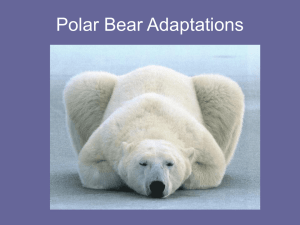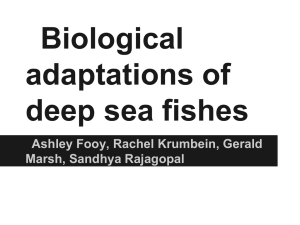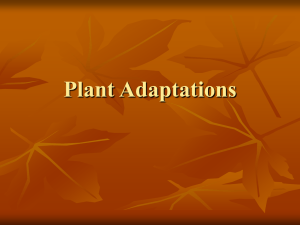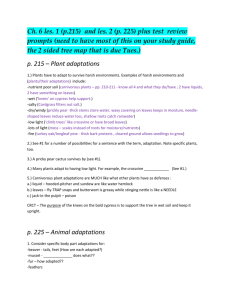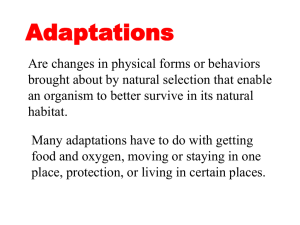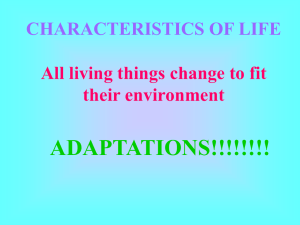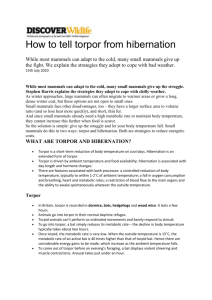Behavioral and Physical Adaptations
advertisement
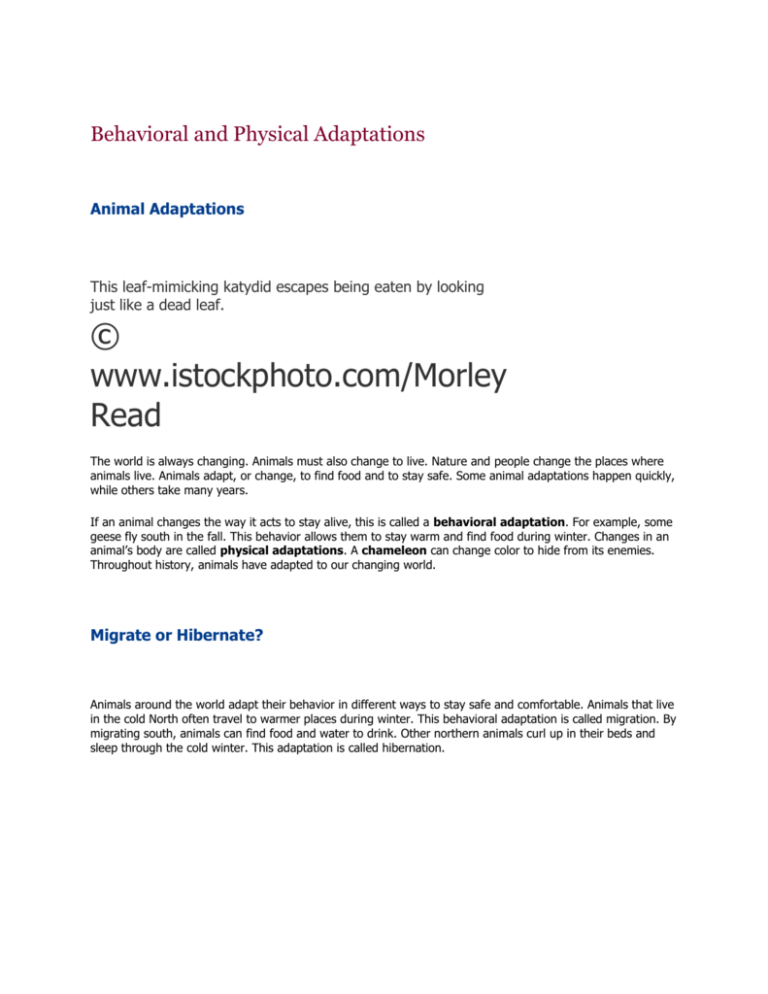
Behavioral and Physical Adaptations Animal Adaptations This leaf-mimicking katydid escapes being eaten by looking just like a dead leaf. © www.istockphoto.com/Morley Read The world is always changing. Animals must also change to live. Nature and people change the places where animals live. Animals adapt, or change, to find food and to stay safe. Some animal adaptations happen quickly, while others take many years. If an animal changes the way it acts to stay alive, this is called a behavioral adaptation. For example, some geese fly south in the fall. This behavior allows them to stay warm and find food during winter. Changes in an animal’s body are called physical adaptations. A chameleon can change color to hide from its enemies. Throughout history, animals have adapted to our changing world. Migrate or Hibernate? Animals around the world adapt their behavior in different ways to stay safe and comfortable. Animals that live in the cold North often travel to warmer places during winter. This behavioral adaptation is called migration. By migrating south, animals can find food and water to drink. Other northern animals curl up in their beds and sleep through the cold winter. This adaptation is called hibernation. Sandhill cranes migrate as far as 2,500 miles (4,023 Km) each year. These cranes spend their summers in Canada, Alaska, and Siberia and their winters in New Mexico, Texas, and Mexico. Shutterstock.com Migration Do any other animals migrate besides birds? Sea animals such as whales, crabs, eels, manatees, and sea turtles are known to migrate. Ants, butterflies, moths, and other bugs migrate, too. Pacific green sea turtles migrate hundreds of miles (km) to lay their eggs on warm beaches. Shutterstock.com Finding Their Way Animals travel hundreds and sometimes thousands of miles (km) during migration. No one is certain how migrating animals keep from getting lost, but people who study animals have a few ideas. Some believe birds use landmarks such as rivers, mountains, or beaches to find their way. Animals might also be led by certain smells in the air. When looking for direction, animals may use the position of the Sun or stars as a guide. Animals might use one or several of these methods when migrating. Each year, millions of monarch butterflies migrate thousands of miles (km) to spend the winter in the forests of Michoacán, Mexico. Omar Torres/AFP/Getty Images Hibernation What happens when an animal hibernates? During hibernation, an animal’s heart slows and its body temperature drops. This means the animal can live on little or no food. How do animals get ready for hibernation? Animals eat lots of food before they hibernate to put extra fat on their bodies. This fat helps keep them warm. Black bears eat lots of nuts, berries, fruit, roots, honey, and small animals to get ready to hibernate. © www.istockphoto.com/Beverly Vycital Snacking and Sleeping During Hibernation Do hibernating animals get hungry? Some animals wake up during hibernation to eat. They store food, such as berries and nuts, in their homes so they can have a quick bite. Chipmunks are one of the animals that snack during hibernation. Every kind of animal hibernates for a different length of time. Painted turtles hibernate for up to four months. Groundhogs sleep in their underground dens for about five months. Bats hibernate in caves for five to six months. Northern black bears can stay in hibernation for over seven months. Chipmunks hibernate from late fall to early spring. They generally first come out of their dens in March. © www.istockphoto.com/Bruce MacQueen Using Adaptations to Find Food Animals use several adaptations to find and catch prey. Many bats find bugs to eat by sending out sound waves. The sound waves hit the bugs, return to the bat, and tell it where to find the bugs in the dark. Owls have eyes that can see in the dark, ears that can hear tiny animals, and sharp claws for catching their prey. Frogs use their long, sticky tongue to catch their food in one quick flick. Fish called archerfish spit at flying prey. These fish have special adaptations, such as sharp eyes and a powerful tongue, to help them get a tasty dinner almost every time. Some animals use their speed to catch prey. For example, cheetahs can run 70 miles per hour (113 km/h), which is faster than any of the animals they hunt. Shutterstock.com Using Physical Features to Adapt Some animals are hard to see against their surroundings. This is called camouflage. For example, polar bears’ white fur makes the bears hard to spot in the snow. This helps them creep up on their prey. Animals also use camouflage to stay safe. Some animals are even camouflaged to look like something else in nature. A stinkbug’s flat green shell makes it look like a tiny leaf! How else do animals hide? Many animals hide by getting out of sight. Animals with sharp claws, such as a mole, can dig holes and hide underground. Turtles carry their hiding place wherever they go. They can suddenly look like a rock. This stick insect, also known as a walking stick, escapes being eaten by looking just like a twig or stem. © Fred Breummer/Peter Arnold Adaptations for Self-Defense Many animals have built-in weapons. Some use their claws and teeth to fight off enemies. Hedgehogs are covered with long, sharp spines. They roll into a ball when danger comes near. Skunks drive off enemies with a terrible smell. Their stinky weapon floats through the air unseen. Many animals run from their enemies. An animal called the pronghorn escapes most enemies by running as fast as 60 miles per hour (97 km/h)! Many sea creatures, such as snails, clams, and crabs, have hard shells that keep them safe. Stingrays, lionfish, and others have sharp, poison-filled spines. An adult hedgehog generally has between 5,000 and 7,000 spines. Shutterstock.com Adaptations for the Heat About 5,000 different kinds of animals live in hot, dry deserts. Many desert animals adapt to the heat by sleeping underground during the day. Coyotes, foxes, kangaroo rats, and other animals come out at night when it is cooler. Kangaroo rats do not drink water at all. These brown and white rats get the water they need by eating seeds. Desert tortoises can last a year without a drink. They get most of their water from the desert flowers and grass they eat. A camel can drink up to 30 gallons (114 l) of water at one time. It will not need water again for several weeks. Black-tailed jackrabbits’ huge ears help these animals stay cool. The jackrabbits’ blood cools off as it moves through their thin, wide ears. © www.istockphoto.com/Steven Love Adaptations for the Cold Penguins fight the cold with feathers. Their outer feathers keep water out. They also have a second type of feathers called down. Down feathers hold in the heat a penguin’s body makes. Some Arctic animals, such as the walrus, seal, and whale, have extra fat that keeps them warm in icy waters. The bears, wolves, foxes, and rabbits that live in the Arctic have a fur coat, which keeps them warm. Their coat gets thicker in the cold winter months. Arctic foxes and other small animals get out of the cold wind by hiding in holes they dig in the snow. Penguins, such as these Adélie penguins, have thick blubber, or fat, under their skin. Along with feathers, this blubber keeps the penguins warm. Shutterstock.com The Importance of Adapting THINK LIKE A SCIENTIST Can you think of some other examples of physical or behavioral adaptations? Musk oxen are large, furry animals that live in cold places. They keep warm by staying close together. Several adult lions and their cubs live together in a group, called a pride. When a mother lion catches food, she shares it with the pride. Many fish swim together in schools. It is hard for an enemy to see and catch a fish in a large school. Most animals in Earth’s history have not adapted to changes. When animals cannot adapt to changes, they die out, or become extinct. Dinosaurs, dodo birds, and woolly mammoths are just some of the animals that are now extinct. A giraffe’s long neck is one example of a physical adaptation. Its long neck lets a girafee eat leaves that other animals cannot reach. www.istockphoto.com/Hazlan Abdul Hakim Find Out More The Web sites and books below can help you do more research on your topic. Web Sites Animal Planet: Top 10 Animal Adaptations http://animal.discovery.com/tv/a-list/creature-countdowns/adaptations/adaptations.html Lincoln Park Zoo: Bactrian Camel http://www.lpzoo.org/animals/factsheet/bactrian-camel-0 The Wild Ones Animal Index: West Indian Manatee http://www.thewildones.org/Animals/manatee.html Books Barnhill, Kelly Regan. Monsters of the Deep: Deep Sea Adaptations. Mankato, MN: Capstone Press, 2008. Heinrich, Bernd. Winter World: The Ingenuity of Animal Survival. New York, NY: Harper Perennial, 2009. Silverstein, Alvin, Virginia Silverstein and Laura Silverstein Nunn. Adaptation. Minneapolis, MN: Twenty-First Century Books, 2008. GLOSSARY behavioral adaptation (bih-HAY-vyuh-rul a-dap-TAY-shun) A change in an animal's actions that helps it keep living. cameleon (kuh-MEEL-yen) A lizard that can change color to match its surroundings. camouflage (KA-muh-flahj) Hiding by looking like the things around one. hedgehogs (HEJ-hogz) Small animals that have hard spines. manatees (MA-nuh-teez) Large plant-eating ocean animals. physical adaptations (FIH-zih-kul a-dap-TAY-shunz) Ways an animal's body has changed that help it keep living. prey (PRAY) Animals that are hunted by another animal for food. spines (SPYNZ) Sharp, pointy things. stingrays (STING-rayz) Flat fish that have spines on their long tail. temperature (TEM-pur-cher) The heat in a living body. tongue (TUNG) A part inside the mouth used to eat, make sounds, and swallow. weapons (WEH-punz) Objects used to hurt, kill, or scare away. Article Citation in MLA (Modern Language Association) format: "Behavioral and Physical Adaptations." PowerKnowledge Life Science. Rosen Publishing Group, Inc., 2012. Web. 7 Sep. 2012 <http://pklifescience.com/article/481/behavioral-and-physical-adaptations> Article Citation in APA (American Psychological Association) format: PowerKnowledge Life Science. (2012). Behavioral and Physical Adaptations. Retrieved September 7, 2012, from http://pklifescience.com/article/481/behavioral-and-physical-adaptations ® The Rosen Publishing Group, Inc. 2012


